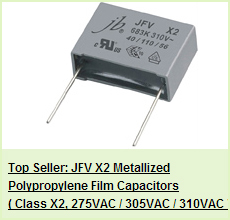2018-10-23 10:27:47
views
31st of October is coming soon, this is an annual holiday in western world. Children will wear their costumes to scare people, and attending costume parties. Moreover, there will have many activities including ghost tours, bonfires, visiting haunted attractions, pranks, telling scary stories, and watching horror films.
Anyway, Halloween is not only celebrated in western world. In Asia, people now will host different activities to celebrate the holiday. Some school will have costume parties, and even markets is starting to sell the mask, pumpkins product. Thanks to the globalization, all the world shares their culture and festival. Wish you and your kids has the best Halloween ever!!
So, don’t hesitate to contact us for any inquiry. jb will offer our best to you~

2010-7-9 20:8:42
views
Aluminum electrolytic capacitors may cause an explosion, fire, or other serious trouble if not used under specified operating conditions. Please familiarize yourself with the instructions given below before using these capacitors Operating temperature and ripple current.
- 1. Keep the operating temperature and ripple current in specified ranges. Applying an excessive current to a capacitor will overheat it, resulting perhaps in short-circuit, ignition, or other fatal fault.
- 2. A capacitor is also a heating component itself. Please be on guard, remembering that it heats up the inside of the equipment. Run the unit under normal conditions and check the temperature of the surroundings of the capacitor.
- 3. The permissible ripple current tends to decline with a rise in the atmosphere temperature (the temperature of the surroundings of the capacitor). Consider a permissible ripple current at the maximum predictable atmospheric temperature. Allow also for the changes in frequency.
Applied voltage and connections
- 1. Capacitors have polarity. Applying a reverse voltage or AC voltage to a capacitor may cause a fire or other fatal fault.
- 2. Use a bipolar capacitor for circuits whose polarity reverses. However, in this case, like any other case,refrain from using such a capacitor in AC circuit.
- 3. When an AC component is superimposed on a DC voltage, prevent the peak value from exceeding the rated voltage. An excessive voltage may cause a short-circuit, fire, or other fatal fault.
- 4. When connecting more than one capacitor in parallel, consider the resistance of the wiring. Establish the connections so that the wiring resistance will be equal at every capacitor.
- 5. When more than one capacitor is connected in series, all capacitors must be of identical ratings. Then connect the balancing resistors in parallel. At that time, design the circuit so that the voltage levels applied to all capacitors become equal.Check that the voltages applied to capacitors do not exceed a rated voltage.
- 6. Do not use such a capacitor for a circuit that is repeatedly charged and discharged quickly. If you are to use such a capacitor for a welding unit or for other charging and discharging purposes, use a capacitor designed on a separate basis.
- 7. Even slow recharging may shorten the service life of a capacitor if its voltage changes greatly. Check it sufficiently as installed on a larger machine or consult Capsun.
Capacitor insulation
- 1. Do not connect the blank terminal (reinforcing terminal) of a multi-terminal (three- or four-terminal) product of the snap-in type to another circuit. It may cause a short circuit.
- 2. The external sleeve of the snap-in type has no insulator. If you need a sleeve with an insulator, consult Capsun.
- 3. Ensure a completely open circuit between the case and the cathode terminal, and between the anode terminal and circuit pattern
Operating conditions
- 1. A splash of water, salty water, oil or other electrically conductive liquid on a capacitor or using a capacitor when it has dew on it may cause a breakdown. Oil on the rubber sealing or safety vent may cause a decline in airtightness. Do not use a capacitor with liquid on it.
- 2. Do not use or leave a capacitor in a place where there is a hydrogen sulfide, nitrous acid, sulfurous acid, chlorine, bromine, or other halide compound gas, ammonia, or other hazardous gas. The ingress of any of the aforementioned gases into a capacitor may corrode it. Avoid fumigating and spraying an insecticide as well.
- 3. Do not use or leave a capacitor in a place exposed to ozone, ultraviolet ray, or radiation.
- 4. Do not use a capacitor in a place where vibration or impact is excessive.
Installa tion Before installaton
- 1. Do not reverse the polarity. Do not use a capacitor to which a reverse voltage is applied, even if it looks problem-free. It must be greatly damaged.
- 2. Do not tighten the curled part (case sealed part) with a mounting fitting or otherwise stress it. Any such practice may cause a liquid leak or sleeve breakage.
- 3. Dropping or otherwise impacting a capacitor may result in a decline in its electric performance,causing a breakdown. Therefore do not cause an impact on it.
- 4. Do not reuse a capacitor which has been installed on a machine and energized. No capacitor can be reused except for those removed to measure their electric performance for a periodic checkup.
Method of installation
- 1. Do not make the safety vent (cap side) of a screw terminal type face downwards. The safety vent may let the electrolyte or compound leak.
- 2. Do not install a wiring or circuit pattern near the safety vent. When the safety vent is activated, the electrolyte may jet out, resulting in a fire or other secondary accident.
- 3. Avoid installing a heating part around a capacitor or in back of a printed wiring board (beneath the capacitor).
- 4. Do not hamper the activation of the safety vent. Above the safety vent (where a screw terminal type is installed on the terminal side, or snap-in type on the case bottom), allow for the following clearances.






